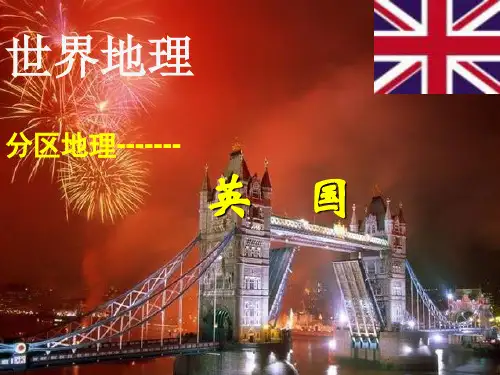英国地理 讲稿
- 格式:doc
- 大小:23.50 KB
- 文档页数:2




哈密地区二中校本课程——《大国崛起》系列之英国之崛起主讲人:韩庆东目录英国之概况英国崛起之路英国崛起之迷英国之概况一.自然地理环境1.地理位臵:英国是位于欧洲西部的岛国,由大不列颠岛(包括英格兰、苏格兰、威尔士)、爱尔兰岛东北部和一些小岛组成。
隔北海、多佛尔海峡、英吉利海峡与欧洲大陆相望。
海岸线总长11450公里。
2.国土面积:英国国土面积24.41万平方公里(包括内陆水域),与此相比,中国广西壮族自治区面积为23.67万平方公里,陕西省面积为20.58万平方公里,湖南省面积21.1875万平方公里。
英格兰地区13.04万平方公里,苏格兰7.88万平方公里,威尔士2.08万平方公里,北爱尔兰1.41万平方公里。
自然地理环境对人类文明的产生起着极为重要的作用,人类文明目前可大概区分为以中国儒家文明为代表的大河文明、以古希腊文化为代表的海洋文明。
大河文明的中国,自古即有安土重迁、血缘与政治结合紧密的特点。
目光转回欧洲西北部的英国,北海和英吉利海峡将不列颠群岛与欧洲其他地区隔离开来,四周由海洋环绕的情形使英国人的家园显得比较易于防守——只要具备适当的防御手段和坚定的防御意志的话。
海洋作为英国的天然疆界曾帮助英国人成功地抵御了来自大陆的入侵者,如16世纪的菲利浦二世、17—18世纪的路易十四、19世纪的拿破仑。
因此海在英国人的生活中是一个最重要的因素,古代社会因海的便利带给不列颠人开放的文化价值观,近代不列颠人为寻求财富而通过大海走遍全世界。
海的便利和屏障作用同在,21英里(34公里)宽的英吉利海峡使英国既容易保持独立,又避开了岛国常出现的孤立、封闭和停滞。
再以俄国为例,大平原之上的森林、草原、河流及其严寒的气候,构成对俄罗斯影响最大的环境条件。
与以地中海为中心的西欧国家相比,俄国缺乏西欧地理环境的多样化。
它的最大特点就是单调的平原。
单调的平原必然使居民从事单调的职业,而职业的单调又容易造成习俗、道德风尚和信仰的一致。







高考地理英国知识点英国是一个位于欧洲西北部的岛国,包括英格兰、苏格兰、威尔士和北爱尔兰四个国家。
英国地理知识是高考地理考试的重点内容之一,下面将针对英国的地理特点进行详细介绍。
一、地理位置英国位于欧洲大陆西北沿海,东濒北海,南临英吉利海峡,西隔爱尔兰海与爱尔兰相望。
它的地理位置决定了其在欧洲大陆的重要战略地位,也为其发展提供了得天独厚的水运条件。
二、地形地貌英国的地形多样,主要可以分为英格兰中、南部的平原地区和苏格兰高地两大部分。
英格兰中、南部地势相对平坦,大部分为农田和城市,最著名的平原有泰晤士河、塞文河和赫伯河三角洲。
苏格兰高地则是高山和湖泊密布的地区,有英国最高峰本尼维斯山。
三、气候特点英国属于温带海洋性气候,由于受到北大西洋暖流的影响,冬季较为温暖,夏季凉爽,降雨分布较均匀。
英国以其多变的天气而闻名,常常出现阴雨天气,尤其是西部和苏格兰地区。
四、自然资源英国拥有丰富的自然资源,其中最重要的是煤炭和石油。
煤炭是英国工业化的基石,曾经在工业革命时期扮演了重要角色。
近年来,英国也在加大可再生能源的开发和利用,如风力发电和太阳能发电等。
五、人口与城市英国是欧洲人口最多的国家之一,人口集中分布在英格兰地区。
伦敦是英国的首都和最大城市,也是欧洲重要的金融中心之一。
除了伦敦,伯明翰、曼彻斯特、利物浦等城市也都有重要的工商业地位。
六、交通运输英国交通发达,具有先进的公路、铁路、航空和水路运输网络。
公路网密集,铁路拥有世界上最古老的铁路系统之一。
伦敦希思罗机场是世界上最繁忙的国际机场之一,为英国和世界各地提供了便捷的航空交通。
七、环境保护英国高度重视环境保护,致力于减少二氧化碳排放,发展可持续发展战略。
英国政府积极鼓励使用清洁能源,减少废弃物产生,并实施严格的环境法规。
八、文化与旅游英国拥有悠久的历史和丰富的文化遗产,吸引着大量的游客。
伦敦塔、巨石阵、巴斯古城等着名景点都是游客们必去之地。
此外,英国文化对全球的影响力也不容忽视,英语语言和莎士比亚戏剧都是英国文化的重要组成部分。
英国地理介绍ppt英国位于欧洲大陆西北部,由英格兰、苏格兰、威尔士和北爱尔兰四个国家组成。
作为一个岛国,英国周围被海洋环绕,与法国隔海相望,地理位置独特。
下面我将向大家介绍英国的地理特点和主要地理景观。
第一部分:概述英国地理位置优越,东西长约1,000千米,南北宽约500千米。
总面积约244,820平方千米,其中陆地面积约241,930平方千米,水域面积约2,890平方千米。
英国是联合王国的缩写,不包括其他海外领地,如直布罗陀等。
第二部分:地形地貌英国地形复杂多样,包括高山、丘陵、平原和湖泊等。
英国最高峰是威尔士的雪顿山,海拔1,085米。
苏格兰高地是最著名的山地地区,有壮丽的峡谷和湖泊,如洛希尔湖和尼斯湖。
英格兰中部是一个广袤的平原,广袤的草甸和农田形成了英国田园风光的代表。
第三部分:河流湖泊英国的河流和湖泊众多,其中最重要的河流是泰晤士河,它贯穿伦敦,并成为英国最长的河流。
此外,塞文河、哈德良河等也是英国重要的河流。
关于湖泊,最有名的莫过于英格兰的湖区,湖光山色吸引了众多游客。
第四部分:海岸线英国拥有众多的海岸线,总长度超过17,380千米。
多样的地理条件使得沿海地区形成了各种不同类型的海岸景观,包括悬崖、沙滩和港口等。
多塞特郡和康沃尔郡的海岸线是著名的风景线,吸引了大量的游客。
第五部分:气候英国气候温和多变,受大西洋海洋性气候影响。
夏季相对凉爽,平均气温在15-25摄氏度之间,冬季相对温暖,平均气温在2-8摄氏度之间。
东部地区相对比较干燥,而西部地区则较为潮湿。
第六部分:自然保护区英国拥有许多自然保护区,这些区域保护了众多珍稀的物种和生态系统。
著名的自然保护区包括湖区国家公园、达特穆尔国家公园和泰恩河河口自然保护区等。
这些地方提供了丰富的生物多样性和迷人的风景。
总结:英国地理多样,拥有壮丽的山脉、美丽的湖泊和多样的海岸线。
丰富的自然资源和优越的地理位置使得英国成为独特而迷人的旅游目的地。
通过这个PPT,我们可以更加了解英国的地理特点,增加对这个国家的认识和理解。
英国地理全套教案目标本教案的目标是为学生提供关于英国地理知识的全面教学。
教案将涵盖英国地理的主要方面,包括地形、气候、人口、城市等。
教学大纲1. 地理位置:地理位置:- 英国位于欧洲西北部,毗邻大西洋和北海。
- 介绍英国与其他欧洲国家的相对位置。
2. 地形:地形:- 介绍英国的地形特点,包括山脉、丘陵、平原等。
- 说明地形特点对英国的自然环境和人类活动的影响。
3. 气候:气候:- 解释英国的气候特点,包括温度、降水和季节变化。
- 讨论气候对农业、旅游和居民生活的影响。
4. 人口:人口:- 分析英国的人口分布情况,包括城市化程度、人口密度等。
- 探讨人口分布对社会和经济发展的影响。
5. 城市:城市:- 介绍英国的主要城市,包括伦敦、曼彻斯特、爱丁堡等。
- 描述这些城市的地理特征、人口和文化。
6. 旅游:旅游:- 探讨英国的旅游资源,包括自然景点和文化遗产。
- 介绍英国著名的旅游目的地,如巨石阵、大本钟等。
教学方法1. 讲授:教师通过讲述和演示介绍英国地理知识。
讲授:教师通过讲述和演示介绍英国地理知识。
2. 小组讨论:学生分成小组,讨论英国地理相关主题,并展示他们的研究成果。
小组讨论:学生分成小组,讨论英国地理相关主题,并展示他们的研究成果。
3. 实地考察:组织学生参观英国的地理景点或举办模拟旅游活动,使学生亲身体验英国地理。
实地考察:组织学生参观英国的地理景点或举办模拟旅游活动,使学生亲身体验英国地理。
评估方式1. 期中考试:学生进行英国地理的笔试,包括选择题和简答题。
期中考试:学生进行英国地理的笔试,包括选择题和简答题。
2. 小组项目:学生以小组形式进行英国地理研究并呈现成果。
小组项目:学生以小组形式进行英国地理研究并呈现成果。
3. 个人报告:学生选择一个英国地理相关话题,撰写个人报告并进行口头展示。
个人报告:学生选择一个英国地理相关话题,撰写个人报告并进行口头展示。
参考资料1. 英国地理导论,作者:John Smith,出版社:ABC出版社,出版日期:2021年。
Land and Geography of the United Kingdom 英国地理Hello, everyone. Welcome to this course: Introduction to Britain and America. First and foremost, we are going to have an overview of Britain.To the west and off the European Continent, there are several thousand islands on the continental shelf. They are generally called the British Isles. Of all the isles, the largest one is called Great Britain. For the convenience’s sake, it is often shortened to Britain. But officially it is still called Great Britain. The island of Great Britain is divided into three political areas, also known as three countries: England in the South, Scotland in the North and Wales in the Southwest.West across the Irish Sea lies the second largest island, that is, Ireland. It consists of two countries: Northern Ireland and the Republic of Ireland. Northern Ireland, together with the three countries on Britain forms UK, the United Kingdom of Great Britain and Northern Ireland.Britain does not share a land border with any other countries except the Republic of Ireland. To the north of the islands the seaway is open between the coasts of Iceland and Norway to the Arctic Ocean. Britain faces Holland, Denmark and Norway across the North Sea. To the southeast and across the English Channel is France. To the south, across the Atlantic Ocean and the Bay of Biscay, are Spain and Portugal. And America and Canada lie on the west corresponding side of the Atlantic Ocean.Britain is over one thousand kilometers from south to north. Its coastline runs about ten thousand kilometers, making it one of the countries with the longest coastlines in the world. In Britain no place is over 120 kilometers from the sea.Among the four countries, England is the largest and most developed. It has an area of about 130,000 square kilometers and covers more than half of the the whole island. Its population is more than 50 million and makes up 87% of the country’s whole population. The River Thames, the second longest and the most important river in Britain, originates in southwestern England and flows through the Midlands of England to London and empties into the North Sea. The importance of England is so great that some foreigners just refer to the whole country as England, a name that people of Scotland, Wales, and Northern Ireland do not like very much. The word “England”was adopted in the 5th century when groups of invaders from Northern Europe, traditionally called the Angles, Saxons and Jutes, took possession of this area. The word “England” means the land for Angles and the word “English” means the language that belongs to the Angles.Scotland is the second largest both in area and population. It is about 78,772 square kilometers with a population of 5 million, less than one tenth of the total population. The Scots established their own kingdom in the 9th Century. The Scottish are proud of their history and the fact the English never conquered Scotland. Edinburgh is its capital. Tourism is one of Scotland’s most important industries. Tourists from all over the world come to enjoy the beauty of Scottish scenery, to drink Scotch whisky and to see Scotsmen wearing kilts and playing bagpipes.Wales is very close to the most densely populated parts of central England. Its entire area is20,780 square kilometers and it covers less than 9% of the whole island. The capital of Wales is Cardiff. The longest river of Britain, the Severn River, originates in mid-Wales and flows through western England to the Bristol Channel and the Atlantic Ocean. Wales has been dominated by England longer than the other parts. In 1282, the Anglo-Normans invaded Wales from England and killed the Welsh prince. The Anglo-Norman king Edward then give his own heir the title of “Prince of Wales” which has ever been borne by the eldest son of the English sovereign. Though defeated, the Welsh people were not willing to give up their culture. This resulted in some differences from England. For instance, its own language, Welsh, is spoken by about 20% of the population, much more than those who speak Gaelic in Scotland and Ireland.Northern Ireland is the smallest of the four both in area and population. It has an area of about 14 square kilometers and occupies the northern one-sixth of the island of the Ireland. The capital of Northern Ireland is Belfast. Lough Neagh, the largest lake in the British Isles, is located in Northern Ireland. Ireland was once an independent country and there had emerged many kingdoms before the Anglo-Norman invaders conquered it in the 13th century. During the English Civil War in the 17th century, Oliver Cromwell invaded the island and this started the immigration of the English Protestants. The Irish people opposed the annexation and fought to regain its independence. Their successful struggle finally led to the founding of the Republic of Ireland in 1927. Since most of the English Protestants refused to separate themselves from their home country, they occupied the northeast corner of the island and kept it within the United Kingdom, which thus became known as the United Kingdom of Great Britain and Northern Ireland.Thank you.。